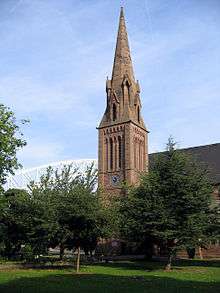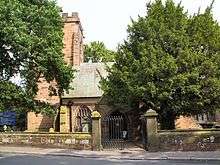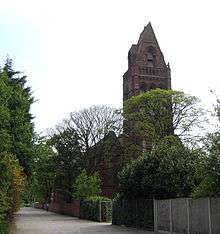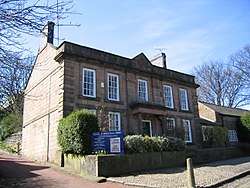Grade I and II* listed buildings in Halton (borough)
There are over 9,000 Grade I listed buildings and 20,000 Grade II* listed buildings in England. This page is a list of these buildings in the borough of Halton in Cheshire.
Grade I
| Name | Location | Type | Completed [note 1] | Date designated | Grid ref.[note 2] Geo-coordinates | Notes | Entry number [note 3] | Image |
|---|---|---|---|---|---|---|---|---|
| Halton Castle | Halton | Castle | 1070 and later | 23 April 1970 | SJ5375182056 53°20′00″N 2°41′45″W |
Built after the Norman Conquest, the castle became the seat of the Barons of Halton. It was besieged twice during the Civil War and subsequently fell into ruin. In about 1800, additional walls were built on its east side to improve its appearance from Norton Priory. It is a scheduled ancient monument, owned by the Duchy of Lancaster and managed by the Norton Priory Museum Trust.[1][2][3][4][5][6][7] | 1130460 | |
| Norton Priory | Halton | Priory | 1115 and later | 23 April 1970 | SJ5483183045 53°20′33″N 2°40′47″W |
This former Augustinian Priory, later an abbey, was reduced to a ruin following the dissolution of the monasteries. A Tudor mansion house was built on the site by Richard Brooke; this was replaced by a Georgian house in 1730. The latter house was demolished in 1928. The site is now a museum which consists of the remains of the priory, including a Norman undercroft with a doorway of 1180 and a Victorian copy, and two blind Norman arcades. It is a scheduled ancient monument and is managed by the Norton Priory Museum Trust.[8][9][10][11][12][13] | 1130433 |
Grade II*
| Name | Location | Type | Completed [note 1] | Date designated | Grid ref.[note 2] Geo-coordinates | Notes | Entry number [note 3] | Image |
|---|---|---|---|---|---|---|---|---|
| All Saints' Church | Daresbury, Halton | Parish Church | 16th century and 1871 | 8 January 1970 | SJ5807082812 53°20′26″N 2°37′52″W |
The parish church of Daresbury was rebuilt in 1871, and retains its 16th-century tower. It is built in red sandstone with a slate roof. Lewis Carroll was born in the vicarage; a stained-glass window in the church depicts characters from his books.[14][15] | 1130450 | |
| Daresbury Hall | Daresbury, Halton | Country House | 1759 | 20 October 1952 | SJ5845182526 53°20′17″N 2°37′33″W |
This former mansion house is built in brown brick with a slate roof in three storeys and three bays. It incorporates a stone plinth and floor bands, rusticated giant pilasters and matching stone quoins.[15][16] | 1330337 | |
| Manor House | Hale, Halton | House | Mid 17th century | 28 May 1958 | SJ4709682182 53°20′02″N 2°47′45″W |
The house was originally built as a parsonage.[17] | 1330339 | |
| Moore Hall | Moore, Halton | Country House | Early 18th century | 8 January 1970 | SJ5804784267 53°21′15″N 2°37′52″W |
Built in rendered brick with a slate roof, this former mansion house has five bays and three storeys, rusticated quoins and a cornice at the second-floor level.[18][19] | 1330357 | |
| All Saints Church | Runcorn Town Centre | Parish Church | 1849 | 7 December 1965 | SJ5106383213 53°20′37″N 2°44′12″W |
Built on the site of an earlier medieval church, the parish church of Runcorn was designed in Early English style by Anthony Salvin. It consists of a five-bay nave with aisles, a chancel which is reduced in both width and height, and a tower with a spire at the southwest corner of the nave.[20][21][22] | 1104888 |  All Saints Church |
| St Luke's Church, Farnworth | Farnworth, Halton | Parish Church | 12th century with later additions | 30 May 1963 | SJ5170687751 53°23′04″N 2°43′38″W |
St Luke's is a parish church constructed in red sandstone dating from the late 12th century. Its tower was added in the 14th century. There were later additions and restorations, the final restoration being in 1894–95. The plan consists of a west tower, a five-bay nave with north and south aisles, a chancel, and north and south porches. At the east end of the north aisle is the Bold Chapel, which contains many family monuments, and the transept is known as the Cuerdley Chapel.[23][24][25] | 1130417 |  St Luke's Church, Farnworth |
| St Mary's Church, West Bank | West Bank, Halton | Parish Church | 1908–10 | 31 October 1983 | SJ5130783790 53°20′56″N 2°43′58″W |
St Mary's parish church was built to replace an earlier church nearby which had been damaged by subsidence, It is constructed in red sandstone in Perpendicular style. It has a nave, aisles, transepts, chancel and a tower at the west end.[26][27][28] | 1130420 | |
| St Michael's Church, Ditton | Ditton, Halton | Roman Catholic Church | 1876–79 | 31 October 1983 | SJ4944885334 53°21′45″N 2°45′40″W |
St Michael's is a Catholic church built for a Jesuit community who had been expelled from Germany in 1872. It is constructed in red sandstone ashlar and has a cruciform plan. At the west end is a tall tower with a saddleback roof.[29][30][31] | 1325926 | |
| Former power house of the Widnes-Runcorn transporter bridge | Victoria Promenade, Halton | Electricity Sub Station | 1901 | 31 October 1983 | SJ5110783706 53°20′52″N 2°44′09″W |
This is a small red sandstone rectangular building in three storeys which originally contained the power house to drive the transporter bridge. It is now used as an electrical sub-station.[32][33] | 1130419 |  Former power house of the Widnes-Runcorn transporter bridge |
| St John's Church | Weston, Halton | Parish Church | 1897 | 5 April 1990 | SJ5088180490 53°19′08″N 2°44′20″W |
St John's Church has a short broach spire, a nave, and a chancel at a higher level, with the vestry below. It was designed by John Douglas. Some of the money for its construction was raised by the choirboys, who wrote appeal letters; it is therefore sometimes known as "the choirboys' church". St John's became a separate parish in 1931.[34][35][36] | 1130422 | |
| Runcorn Railway Bridge | Runcorn Bridge, Halton | Railway Bridge | 1864–68 | 6 October 1983 | SJ5089483431 53°20′48″N 2°44′18″W |
Spanning the River Mersey to provide a more direct rail connection between London and Liverpool, the bridge is constructed of three wrought iron girders carried on four sandstone piers. It is approached on each side by viaducts. The structure was designed by William Baker and now carries the Liverpool branch of the West Coast Main Line.[37] | 1130418 | |
| Castle Hotel | Halton | Hotel | 1737 | 20 October 1952 | SJ5376382016 53°19′59″N 2°41′45″W |
This building was originally integrated into the walls of the castle and used as a court house. The court room was on the first floor and prisoners were housed in the cellars. The entrance to the court room is approached by an external stone staircase, and its doorcase is surmounted by the Royal Arms. It is now a public house.[41][42][43] | 1115543 | |
| Halton Old Hall | Halton Common, Halton | House | 1693 | 4 March 1969 | SJ5392681925 53°19′56″N 2°41′36″W |
This is a house which was rebuilt after having been damaged in the civil war. A two-storey wing was later added to the north. The house has mullion windows and a studded door.[44] | 1130461 | |
| Chesshyre Library | Halton | Library | 1730 | 20 October 1952 | SJ5377681887 53°19′55″N 2°41′44″W |
The library was built for the incumbent of St Mary's Church by Sir John Chesshyre. Its doorcase is surrounded by Ionic columns with a triangular pediment. The roof has a cornice, a solid parapet, stone gables, and a chimney. Since 1975, it has been linked to the church hall and used as a meeting room.[41][45][46][47] | 1115560 | |
| Seneschal's House | Halton | House | 1598 | 20 October 1952 | SJ5376682237 53°20′06″N 2°41′45″W |
This is the oldest standing building in Runcorn. It was latterly a farmhouse although was originally built by the judge John King, called to the bar in London in the late 16th century and was originally known as "John King's New House"; the occupation of the original owner of the house, led to a later owner, Geoffrey Barraclough, Professor of History at Liverpool University in the mid 20th century coining the current name of the house. The house was, in fact, inhabited originally by a seneschal, that is the original owner, John King. The house is E-shaped and its gables have corbels, moulded copings and sandstone ridges.[41][48] | 1330346 | |
| Tricorn Public House, formerly Hallwood | Palacefields | Country House | c. 1710 | 23 April 1970 | SJ5405880792 53°19′19″N 2°41′28″W |
Now a public house, this was formerly a wing of a mansion house called Hallwood, the birthplace and home of Sir John Chesshyre. It is in brown brick and stone with a slate roof.[49][50][51][52] | 1130425 |  Tricorn Public House, formerly Hallwood |
| Halton Vicarage | Halton | Vicarage | 1739 | 20 October 1952 | SJ5377781918 53°19′55″N 2°41′44″W |
The vicarage was paid for by Sir John Chesshyre. On its front are pilasters and a Doric porch. The windows are sash windows. The eaves consist of a cornice with a solid parapet, which is pedimented over the centre bay. It is still in use as a vicarage.[41][53][54] | 1320399 |
Notes
- The date given is the date used by Historic England as significant for the initial building or that of an important part in the structure's description.
- Sometimes known as OSGB36, the grid reference is based on the British national grid reference system used by the Ordnance Survey.
- The "List Entry Number" is a unique number assigned to each listed building and scheduled monument by Historic England.
References
- Historic England, "Halton Castle, Runcorn (1130460)", National Heritage List for England, retrieved 25 March 2015
- Historic England, "Halton Castle: a ruined shell keep castle on the site of an earlier motte and bailey (1015606)", National Heritage List for England, retrieved 25 March 2015
- Whimperley, Arthur (1981), Halton Castle: An Introduction & Visitors' Handbook, Arthur Whimperley
- McNeil, Robina (ed.) (1987), Halton Castle: A Visual Treasure, Halton Castle: A Visual Treasure: North West Archaeological Trust, pp. 1–20CS1 maint: extra text: authors list (link)
- Starkey 1990, pp. 8, 30–32, 57–58, 75.
- Nickson 1887, pp. 119, 148–149.
- Hartwell et al. 2011, p. 566.
- Historic England, "Remains of Norton Priory (1130433)", National Heritage List for England, retrieved 25 March 2015
- Historic England, "Augustinian Abbey known as Norton Priory (1015603)", National Heritage List for England, retrieved 25 March 2015
- Greene, J. Patrick (1989), Norton Priory: The archaeology of a medieval religious house, Cambridge University Press, ISBN 0-521-33054-8
- Starkey 1990, pp. 9, 35–40.
- Nickson 1887, pp. 32–39, 124–126.
- Hartwell et al. 2011, pp. 568–569.
- Historic England, "Church of All Saints, Daresbury (1130450)", National Heritage List for England, retrieved 25 March 2015
- Hartwell et al. 2011, p. 325.
- Historic England, "Daresbury Hall (1330337)", National Heritage List for England, retrieved 25 March 2015
- Historic England, "The Manor House, Hale (1330339)", National Heritage List for England, retrieved 25 March 2015
- Historic England, "Moore Hall (1330357)", National Heritage List for England, retrieved 25 March 2015
- Hartwell et al. 2011, p. 486.
- Historic England, "Church of All Saints, Runcorn (1104888)", National Heritage List for England, retrieved 25 March 2015
- Starkey 1990, pp. 95–97.
- Hartwell et al. 2011, pp. 559–560.
- Foster 1981, pp. 35–42.
- Pollard & Pevsner 2006, pp. 653–655.
- Historic England, "Church of St Luke, Widnes (1130417)", National Heritage List for England, retrieved 25 March 2015
- Diggle 1961, pp. 120–121.
- Pollard & Pevsner 2006, pp. 648–649.
- Historic England, "Church of St Mary, Widnes (1130420)", National Heritage List for England, retrieved 25 March 2015
- Diggle 1961, pp. 66–67.
- Pollard & Pevsner 2006, p. 657.
- Historic England, "Church of St Michael, Ditton (1325926)", National Heritage List for England, retrieved 25 March 2015
- Thompson 2000, pp. 12–15.
- Historic England, "Former Transporter Bridge Power House (1130419)", National Heritage List for England, retrieved 25 March 2015
- Historic England, "Parish Church of St John the Evangelist, Runcorn (1130422)", National Heritage List for England, retrieved 25 March 2015
- Starkey 1990, pp. 99–100.
- Hartwell et al. 2011, pp. 664–665.
- Historic England, "Runcorn Bridge railway bridge over River Mersey (1130418)", National Heritage List for England, retrieved 25 March 2015
- Starkey 1990, pp. 166–170.
- Nickson 1887, pp. 202–206.
- Cowan 1990, pp. 5–7, 10.
- Hartwell et al. 2011
- Historic England, "The Castle Hotel Public House, Runcorn (1115543)", National Heritage List for England, retrieved 25 March 2015
- Starkey 1990, p. 70.
- Historic England, "The Old Hall, Halton (1130461)", National Heritage List for England, retrieved 25 March 2015
- Starkey 1990, pp. 51, 77–80.
- Historic England, "The Parish Library, Halton (1115560)", National Heritage List for England, retrieved 25 March 2015
- Nickson 1887, pp. 114–117.
- Historic England, "The Seneschal's House, Runcorn (1330346)", National Heritage List for England, retrieved 25 March 2015
- Historic England, "The Tricorn Public House, Runcorn (1130425)", National Heritage List for England, retrieved 25 March 2015
- Starkey 1990, pp. 20, 77.
- Nickson 1887, p. 112.
- Hartwell et al. 2011, p. 568
- Starkey 1990, p. 81.
- Historic England, "The Vicarage, Runcorn (1320399)", National Heritage List for England, retrieved 25 March 2015
Notes
External links
![]()
This article is issued from Wikipedia. The text is licensed under Creative Commons - Attribution - Sharealike. Additional terms may apply for the media files.














